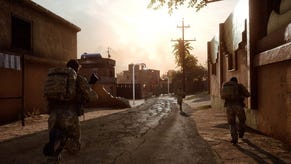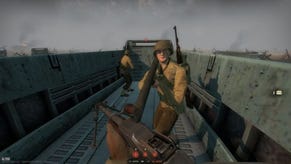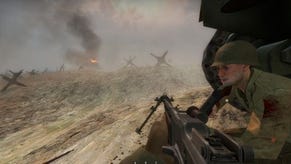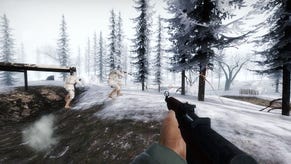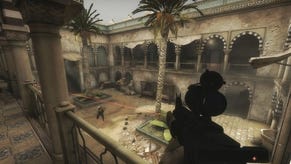Hands On With Insurgency
Swift, Sudden Death
The big question with any Insurgency – who's it for? For 'the people', that nebulous concept underlying the promises of kings and tyrants? Against the foreign devil? Or is Insurgency for folk who find Counter-Strike too arcadey, ArmA too serious, and want something that's a bit like Red Orchestra but is not Red Orchestra?
Eternal questions like this are addressed below.
Forgive the histrionics, but when a game's called Insurgency in this day and age it inspires all sorts of thoughts – the first being we may we due a smarter kind of 'shoot the man' FPS than usual. Insurgency is not this. Instead it's a narrative-free team-based military shooter, one that tiptoes a tightrope between Serious Guns Yo and wave-based spawning.
At times it wobbles, but Insurgency's disparate ideas just about stay upright thanks to the quality of its gun mechanics. Now I'm not the kind of dude who masturbates over pictures of disassembled AK-47s, but I do enjoy the feel of a good virtual weapon, and everything about Insurgency's hardware is high-on perfect in terms of feel.

Bringing up a gun's sights is a slow business. Hip-firing at any distance over ten centimetres is a big no-no. Reloading almost anything gives you time to make a cup of tea. And when you click to pull the trigger, those bullets instantly down any target you hit. So many games feel like you're toting around a fantasy cannon that fires fruit pastilles. Insurgency's guns feel like weapons.
The flipside of this is that, if you're anything like me, you're going to spend an awful lot of time either dying or crawling around on all fours before seeing an enemy and then dying. Insurgency makes you jump constantly, because death is nearly always so swift and unexpected. But one of the cool things about Insurgency is that it melds these mechanics with much more 'gamey' context and modes than you'd expect.

The Counter-Strike comparison, for example, was never far from my mind while playing because you're constantly accumulating Supply, the currency used to purchase weapon upgrades and assorted other kit between spawns. Unlike Counter-Strike you retain what you've bought over deaths, meaning that even an average player cough can soon enough be toting some pretty impressive hardware.
Alongside a standard deathmatch mode, Insurgency offers several variants on King of the Hill – including one called Occupy with a central point that, once captured, grants your team extra reinforcement waves. To be honest these modes, while obviously an essential part of the package, didn't inspire me. Insurgency's the kind of game where, when you let people camp, they're going to camp at Max Efficiency, and these kind of fixed-point modes were perfect for it.

Insurgency finds its own identity in the Push and V.I.P Escort modes. The former has one team capturing three objectives one after the other and, while it might sound like another King of the Hill mode, these changing focal points pull your team together for concentrated attacks and ambushes. The icing on the cake here is that as you push and capture a point, your team gains more reinforcement waves – so a brilliant defence can lead to a very short game, or two evenly-matched teams will drag a match out to epic lengths.
Now Push mode is fairly awesome for the most part, but there is a qualifier. Most games I'd be enjoying the firefights and positional play enormously, then would die once and thereafter respawn and get sniped by people I never saw. Insurgency is just that type of game – of course there are players who make it their business to camp out spawning positions, and of course they're going to try and do it in every match. In some games my team was good enough to hunt down these individuals quickly, and in others we were headless chickens. Put it this way: if you're playing on a team with voicechat this won't be a big issue, but if you're soloing with randoms then it often is.

V.I.P Escort doesn't have this problem, and it's where I had easily the best time with Insurgency. The idea's simple: one team has a VIP that they have to escort to either of two extraction zones. All sorts of things happen: your team might move fast as one group, big enough to punch through a thinly-spread defence and reach safety before there's any further response. The mass of the team might go off in one direction, pulling the enemy towards them, while the VIP sneaks round another way with a small escort.
But most of the time everything just goes to hell, and the VIP tries to pick a way through it. There's a wider point about Insurgency here: it's a game that's easily at its best when the objectives are shifting, and players have to negotiate the environment and fight at the same time. In the modes that let people sit around the overwhelming majority of players seem to – big surprise – just sit around with their iron sights up waiting for the next victim.

It's worth mentioning that Insurgency also has co-op ambitions but – at this stage – things aren't quite coming together. This may have just been bad luck, but I tried to play co-op missions with different buddies on two occasions, and both times the enemy AI wasn't working. Well, I guess it worked if the aim is for insurgents to run towards you while not firing their guns.
So there are elements of Insurgency that are very much wait and see. But what matters at the moment is, despite a low number of active players, the fundamental gunplay feels really satisfying – there's a thunk of finality to pulling the trigger every time, a sense that you can kill or be killed in any instant.
The question is whether the developers can build a structure around this that's good enough to tempt you away from the obvious alternatives. Let's get serious: going head-to-head with Counter-Strike, or even Red Orchestra, is going to be a losing battle. It's in modes like Push and V.I.P Escort, which give direction to its team-based gunplay and create a flow even among strangers, that Insurgency might find a cause worth fighting for.
Insurgency is out now.




